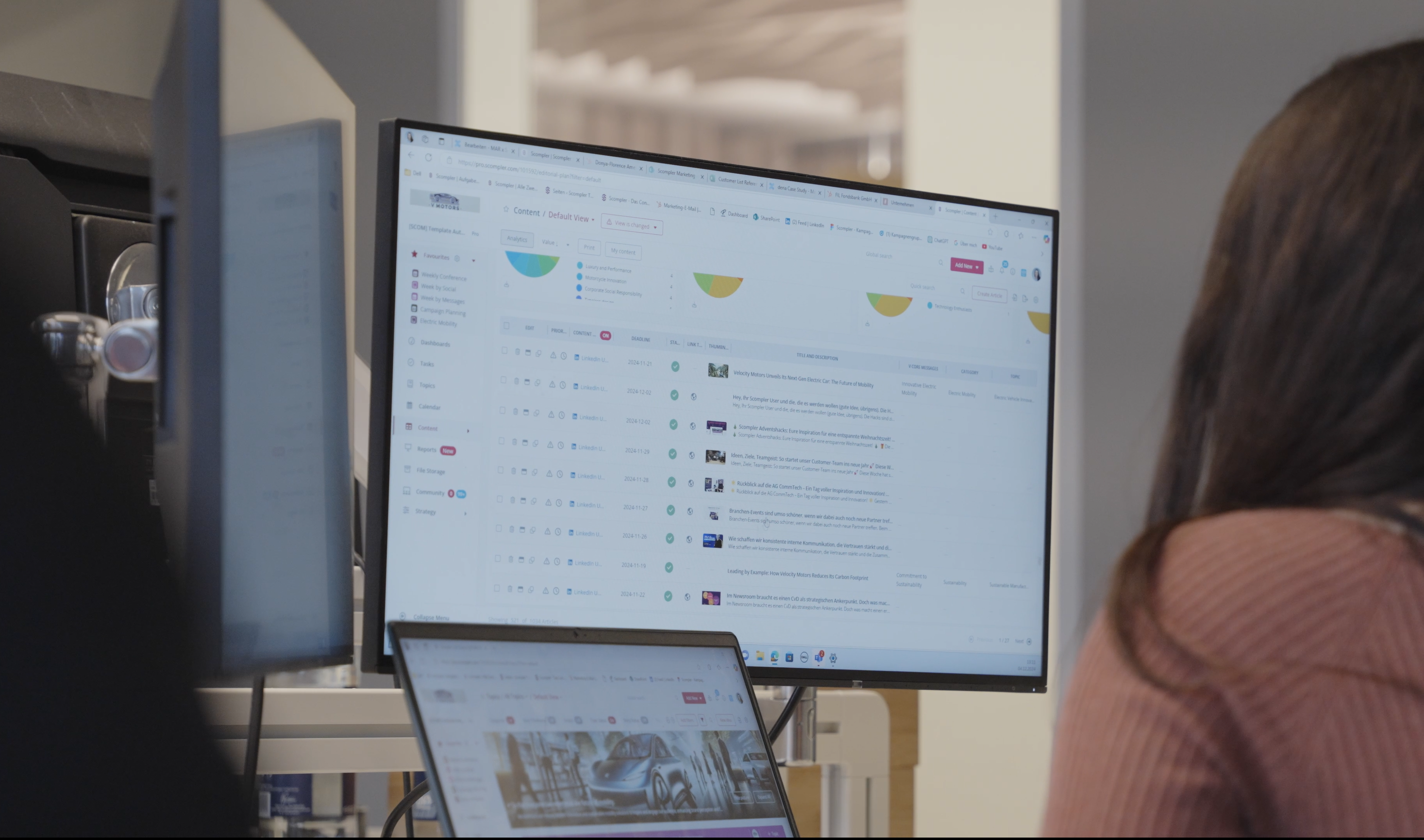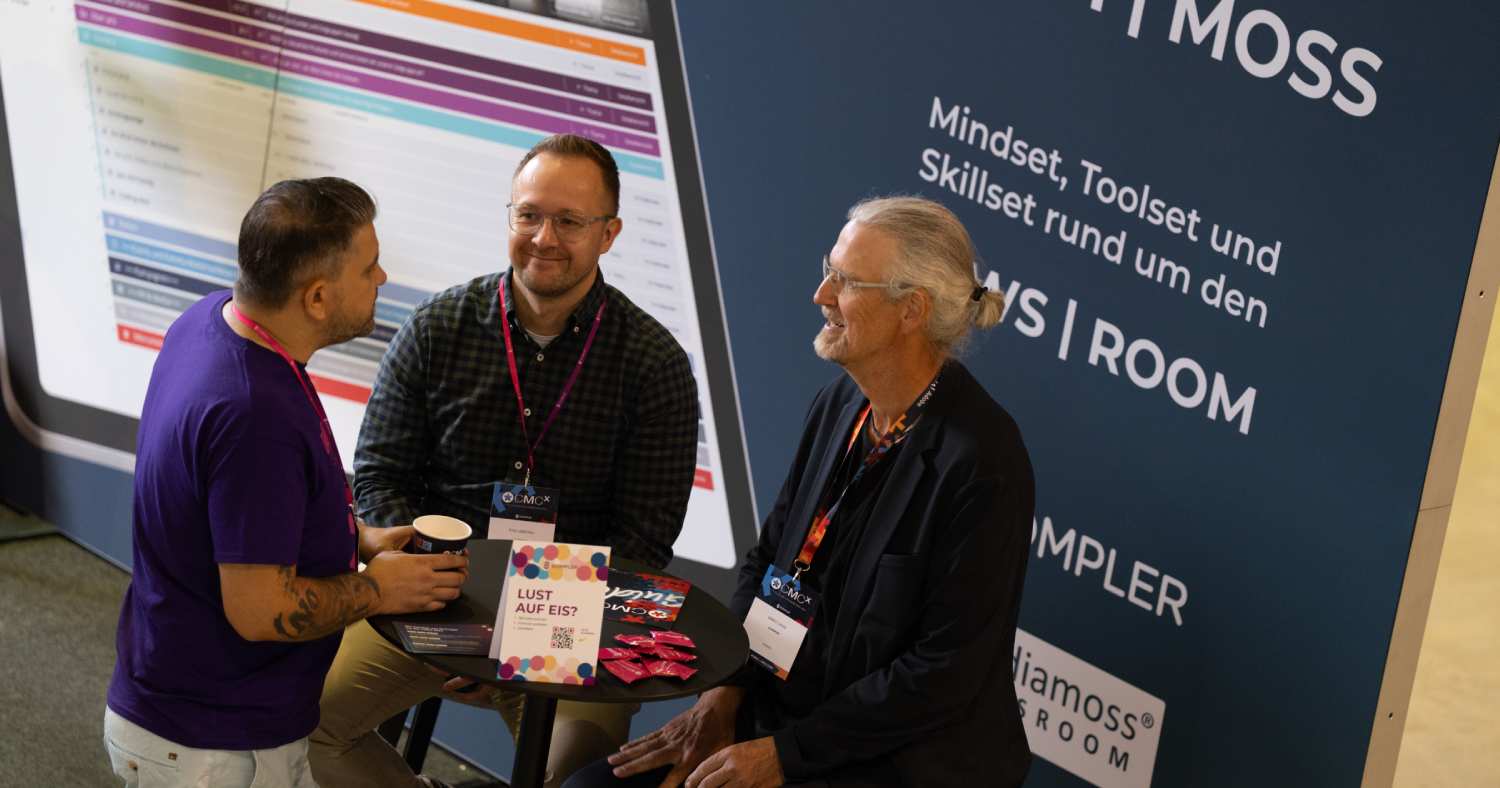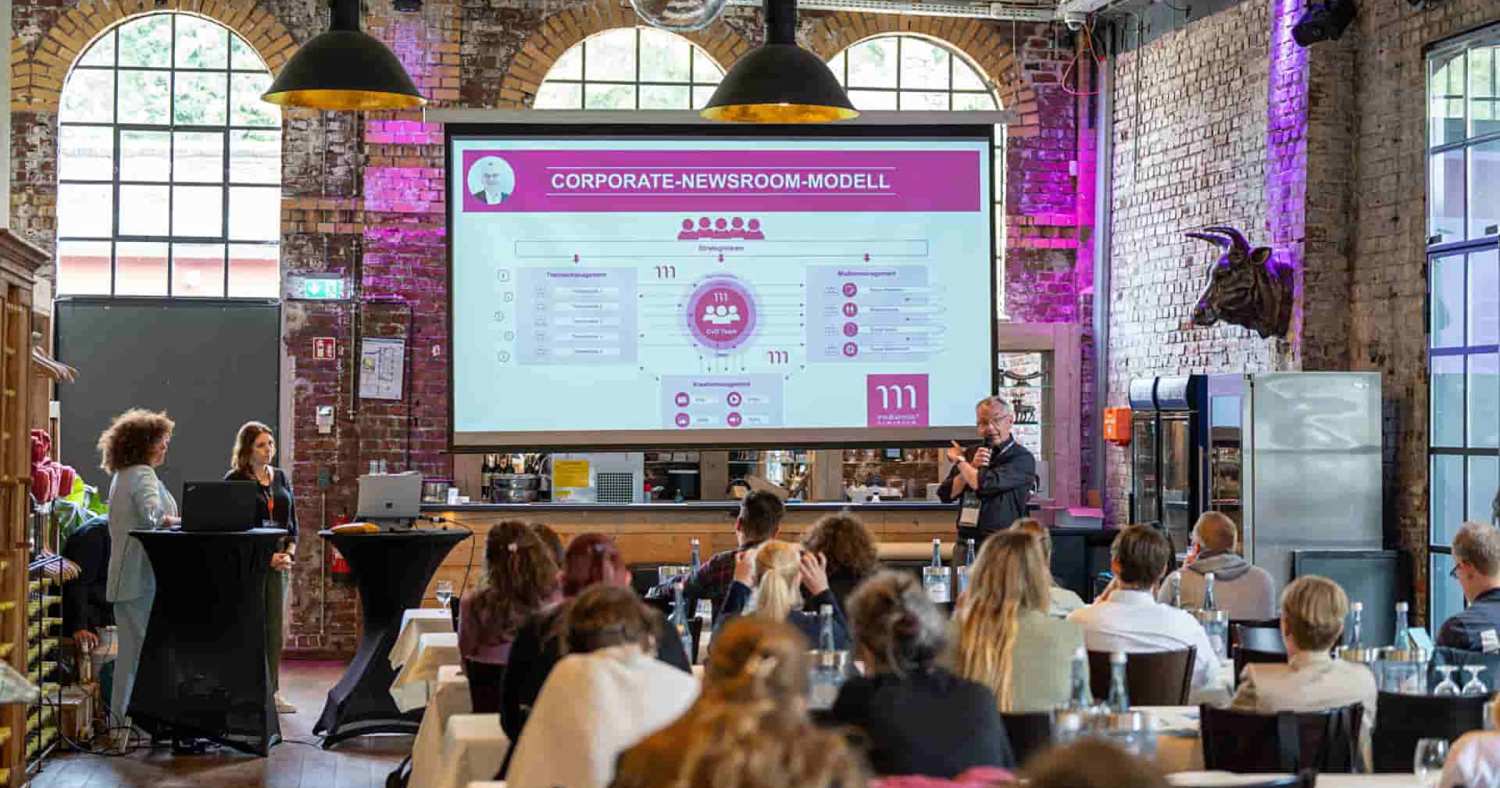The 8 levers of strategic content marketing
One achievement of "content marketing" is that companies are starting to think more "empathetically", i.e. more from the customer's point of view. But this is just the beginning. We need personas, no question about it. We have to think about their "customer journey", that's a must. But even that is not enough. Above all, we need a "holistic view" of all possible touch points. This article is intended to highlight the areas where our target groups come into contact with content that affects us. In order to communicate effectively, we as communicators must have an influence on all areas. And one thing in particular becomes clear: how necessary it is for departments that are often organized in silos to work together. Good, modern companies are already doing this. This article aims to show how close this should (or could) become.
Anyone who starts to deal with "content" or "social media" will sooner or later come across "the chart with three circles", which shows three types of media: Owned Media , Earned Media and Paid Media.
This actually refers to "media", i.e. means of communication, and specifically the model means the channels, or even more precisely, whether and how I as a communicator can use the channels. I have complete control over my own channels ("owned media") and can post and write what I like there, e.g. on my own website. I can only use paid media if I pay for it, i.e. mainly advertising. And to get into "earned media", i.e. editorial coverage, I have to "earn" it first, usually through PR. In other words: "Owned media" is my own car, "paid media" is the cab and with "earned media" I hitch a ride.
Owned media is your own car, paid media is the cab and earned media is the hitchhiker"
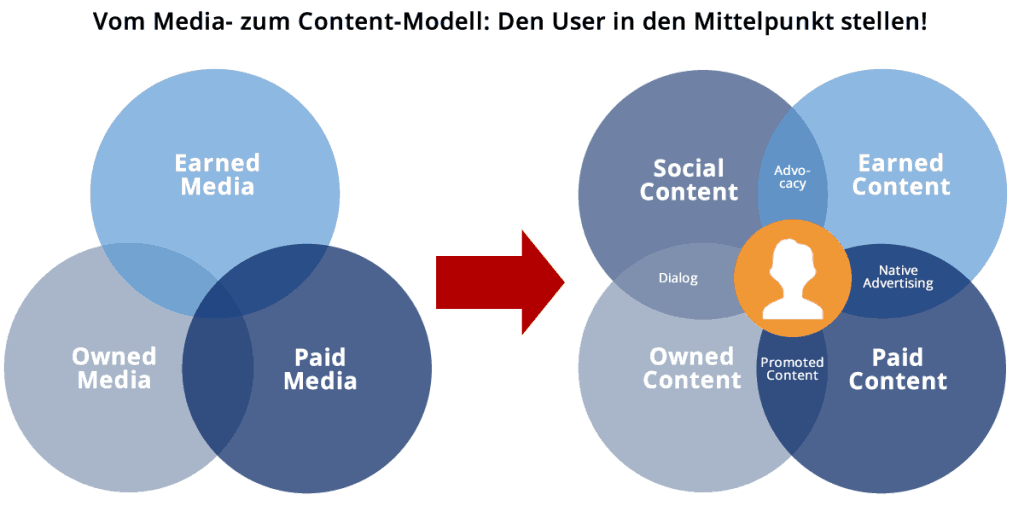
The "media model" is outdated and inadequate!
However, anyone who delves deeper into the topic of content strategy will eventually realize how outdated and inadequate this model is. Because it makes the same mistake as so many of the (old) marketing theories: It doesn't look from the user's perspective. And it does not take into account the special features of the digital world. Firstly, it is now only indirectly important "where" I speak, much more important is "what" I say. And secondly, the recipient doesn't just perceive what "I" say; on the Internet, everything mixes into an incredible polyphony, and it can all too quickly turn into a cacophony.
Then my beautifully crafted messages are either overlaid or counteracted. Anyone who thinks "strategically", i.e. goal-oriented, would do well to consider what the "recipient horizon" is. And ask yourself the question: How can we as communicators control what "content" the target group receives? How do we manage the "polyphony" (= many voices), prevent a "cacophony" (= bad voices) and perhaps even create a "symphony" (= with a common voice)?
Only in the triad of message, acceptance and reach does content marketing generate value
And here is the central graphic:
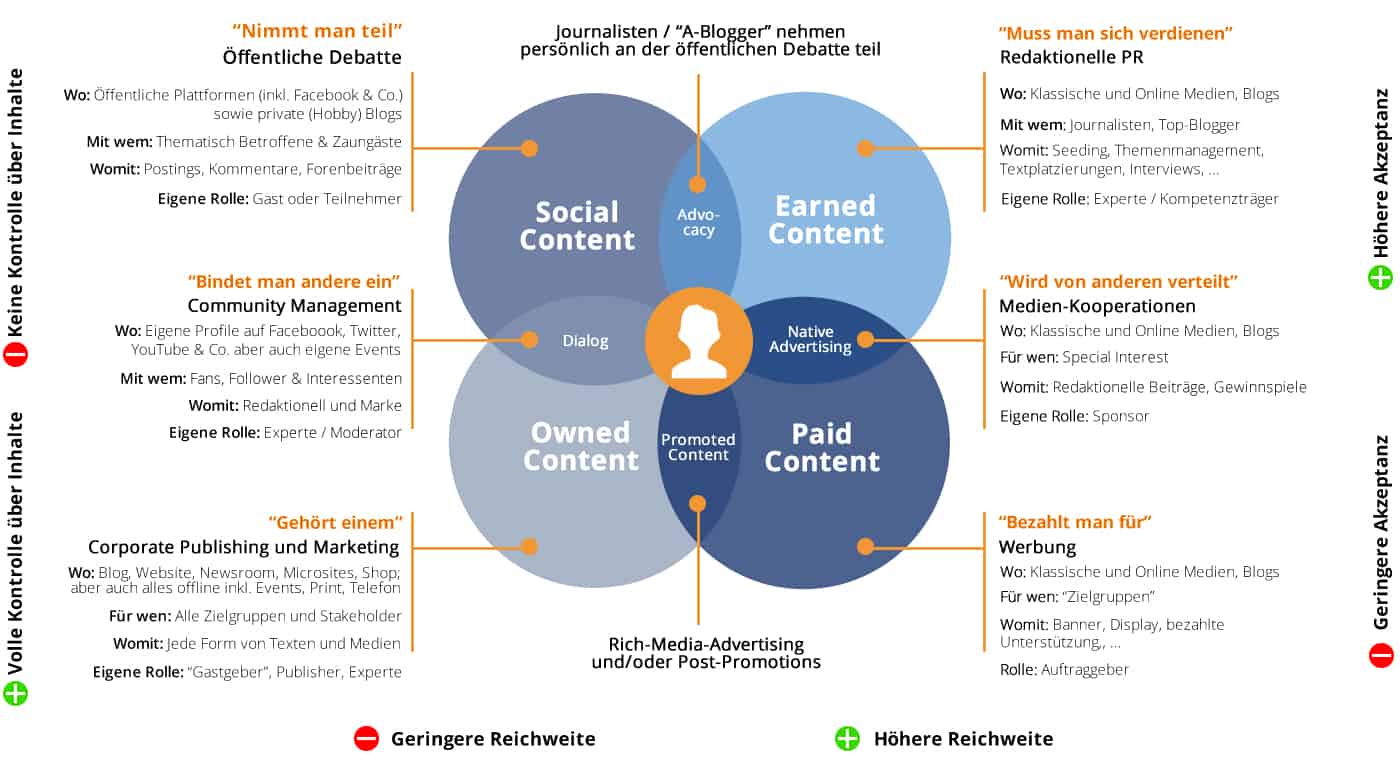
The dimensions of content control
"Content control" is a nasty word, isn't it? Do you always have to "control" everything? Spontaneously, you will have to say anyway: We have no control! And depending on your taste, you can also add a "more". The "loss of control" in the age of social media is almost proverbial. First of all, a closer look reveals that "content" has three dimensions: The understanding of the content, the reach and the acceptance.
We have to say goodbye to a concept of control that has dominion over every detail. There is no such control and never has been. But we can understand "control" as controlling the overall impression. Like a current account. Our task is to keep our reputation account in the black. And even if there are "uncontrolled withdrawals", we can still balance the account. And that is exactly what modern communication management is all about: knowing where withdrawals are being made, whether they are relevant and, if so, replenishing the account in a targeted manner.
A systematic understanding of content: Eight levers of influence
The four basic types of content
And in a slightly different model of the "media model", we can represent all three dimensions well. The terms are similar, but they do not refer to the "medium", but to the "content". From the recipient's point of view, the channel is irrelevant; they are only interested in the content that they receive via these channels. And nowadays, the types of content are mixed up in the channels; all types of content can be found in every medium: paid content (advertising), editorial content, content created by companies (see advertorials and native advertising) and content from readers in the form of comments. In detail, this results in three basic types of content:
- "Owned content" is the content that I, as the communicator, have full control over. I can control 100% of what I say. I can, if I like, move every single pixel to wherever I like. I can think about every single I-point. And I can run a text through 20 correction loops. However, I still have little or no control over the reach of this content. And the acceptance and credibility of this content is generally low - at least lower than with editorial content, for example.
- "Paid content" is the content where I have full control over the reach. At least "technically". I can go to my media agency (or Facebook's ad manager) and choose exactly who I want to reach and how many of them. I can control this through "targeting" and by using media: the more I invest, the more people I reach. At least in theory. I can also control the content with paid content, but only to a very limited extent because space is usually very limited. Because space costs money. And just as with owned content, the acceptance and credibility of this content is low.
- "Earned content" is the content that I have to "earn" as a company. It is mainly created by editors and "A-list bloggers". The reach is usually significantly higher than with in-house media, and the credibility and acceptance are also very high, but there is no control here. Nevertheless, it is possible to "influence" the content. This is the domain of PR, as a company you can know the editors and bloggers with the widest reach and/or who are particularly credible
- "Social content" is content that is created "together" by the public. This also has to be earned. However, it is much more heterogeneous than "earned content", much more chaotic, basically even completely anarchic. This content can perhaps be moderated, but it is beyond any influence or even control.
A systematic understanding of content: Eight levers of influence
The mixed forms of content
What is interesting about this model are the hybrid forms. This is because other types of content are created at the interfaces:
- "Fan dialog": Interaction occurs at the interface between "owned" and "social". It is important to understand that dialog also generates content - and that this content is both observed and used by recipients. On the one hand, the public assesses how a company deals with its stakeholders based on the dialog. On the other hand, this content contains a lot of information - just think of "service communities", where you often no longer have to ask a question yourself, but can read how your question has already been answered for someone else.
- "Native advertising ": A (new?) discipline is currently emerging at the interface between "earned" and "paid", namely "native advertising". This is a mixture of editorial content and paid advertising. This used to be called advertorials. As a company, you can increase both the reach and the acceptance of your content, but you lose some control over the content: This is because you are no longer allowed to make it promotional but have to make it editorial.
- "Advocacy": And at the interface between "earned" and "social", "advocacy" or "ambassadorship" arises. When credible and high-reach journalists or bloggers participate in the public conversation as individuals, this strengthens the reputation of the content immensely.
- "Promoted content ": New types of content have emerged at the interface between "owned" and "paid" content, such as rich media ads or "post promotions". We call them "Promoted Content". This allows companies to either increase the reach of their owned content (e.g. through Google Adwords or Facebook post promotion) or increase the previously "thin" content of advertisements.
The eight levers of content control
And here they are, the eight levers. The model helps to improve the orchestration of content in content marketing - namely the content that (potentially) reaches the user. So if you take "content" and "content marketing" seriously, you have eight "levers" that you can use. And with all of these levers, they have different goals and different roles (see above). If you want to be really good, you use all of these levers and orchestrate them. But I want to repeat once again: it's the content that counts! It doesn't depend on "whether you are in the channel", for example whether you have a "clipping" in the "FAZ".
A systematic understanding of content: Eight levers of influence
This is the channel-oriented way of thinking. It depends on what is in the channel. And then it is also important that the other content types in the channel do not lead to the cacophony described above and, for example, that all users complain in the comments at faz-online.de and on Facebook (in the comment to the link there) about what rubbish the article is (social content). Or if there is a link to the website in the article, which then suddenly contains other messages (owned content). It all depends on the content! Or more precisely: it depends on what kind of content the user receives. And the user takes up different content on the topic!
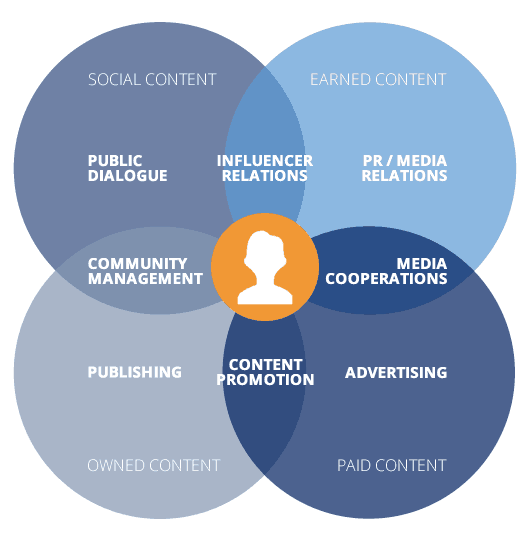
- Publishing: The basis is almost always "owned content". Depending on the strategy, you can align it more with the company and thus strengthen the brand, or make it more editorial to increase acceptance and reach - through more sharing, a higher edge rank and better placement in search engines.
- Content promotion: is an interesting hybrid form to increase the reach of "owned content" or to enrich the content of classic ads. This is "advertising for content". This is different from traditional advertising, which typically promotes a product directly.
- Advertising: Traditional advertising continues to play a major role in generating reach - especially if you have messages that (only) serve the interests of the company.
- Media cooperation: The mix of "earned" and "paid" is increasingly becoming a very valid way of distributing content with good reach and high acceptance. Native advertising, a modern interpretation of advertorials, is very much in vogue, but joint competitions, quizzes and prize promotions also work very well.
- PR / media relations: "Earned content" is the classic field of activity for PR and blogger or influencer relations. The reach and acceptance are even higher than with "native advertising", but you have to think even more editorially and put your own interests even further aside.
- Influencer relations: "Advocacy" is the highest art of PR and blogger relations: When you succeed in getting the journalist or blogger to not only write about you as part of their profession, but also to be personally convinced.
- Public Dialogue: And "Dialogue" is ultimately the interface between "social" and "owned". This includes both community management and service. This content is extremely valuable because it is created "by itself" and is very authentic and therefore accepted.
- Community management: "Social content" is the type of content that can be influenced or even controlled the least. Here, everyone writes what they want. Influence can only be exerted through genuine behavior - both in real life through good products and services and in public communication, especially through good community management.
The model makes it clear how interwoven all disciplines are. From the consumer's perspective (in the middle of the graphic), everything blends into a great polyphony - either as a synphony or a cacophony. Companies that manage all eight disciplines well will be at the forefront of the new media world. And the more silos are broken down in companies, the better.

